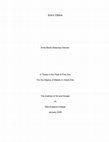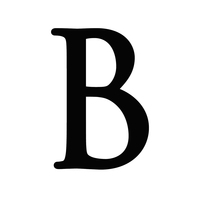Papers by Anne-Marie Delaunay-Danizio
This capstone paper shows how a North American encyclopedic museum adjusts to its time by integra... more This capstone paper shows how a North American encyclopedic museum adjusts to its time by integrating a contemporary art gallery in its collection and by displaying the works of non-European artists.
Drafts by Anne-Marie Delaunay-Danizio

Eve's Clitoris, 2020
Abstract
During the first semester of my MFA program, I identified my critical theory grid as a ... more Abstract
During the first semester of my MFA program, I identified my critical theory grid as a psychoanalytic feminist approach. Moreover, in a note to my advisor, I stated that, “men are allegedly afraid of castration while women are the ones who are actually castrated.” When, during my second residency I identified myself as a feminist, my advisor’s response was, “What kind of feminist are you?”
Almost two years later, my current thesis advisor asked me whether my approach was feminist or queer. After further research, I concluded that I situated myself neither as a queer theorist, nor as a 1970s feminist, but as a clitoral feminist. I coined the term clitoral feminist (if someone else has done so, I would be happy to hear it), to express my own predicament, and the predicament of all those born with a clitoris, as clearly and loudly as possible.
In this thesis, I articulate the links between the personal/intimate, and the wider cultural context in which I am evolving. I use Freudian psychoanalytical theory and early French feminist theory as expressed by Luce Irigaray, and offer a feminist revision of Judeo-Christian, Classical and ancient mythologies. I also included recent scientific research and recent findings on the clitoris. By doing so I intertwine the personal and the theoretical with my art-making process.
Early French feminism or 1970s feminism could be defined as focused on a clear-cut distinction between male and female, according to their sexual reproductive function. Clitoral feminism is focused on the blurring of sexual and gender roles. Its point is to challenge sexual differences and normative heterosexuality. 1970s feminists might say “we are persecuted by an oppressive patriarchal system because of our ability to create life.”
Clitoral feminists might say, “We are persecuted by an oppressive patriarchal system, because a crucial part of our body functions like the male organ.” Both statements are true. However, by focusing on the reproductive side of sexuality early French feminists recreate a clear-cut binary separation between male and female, while clitoral feminism is inclusive, based on a playful non-reproductive sexuality that blurs male and female sexuality and gender roles.
According to 1970s feminism, there are three stages in a woman’s life Maiden, Mother and Crone. According to my shifting identities, the three stages of my artistic and life journey are: Castrated Woman, Mother and Whole Again.
The section titled Castrated Woman illustrates the beginning of my artistic career as an abstract painter. The section titled Mother illustrates the shift from painting to iconographic paper-maché sculptures centered on 1970s feminism, as they connect to my experience as a mother. The section Whole Again is about my return to abstract painting, as a mature woman asserting her creative drive.
During the first semester of my MFA program, I identified my critical theory grid as a psychoanalytic feminist approach. Moreover, in a note to my advisor, I stated that, “men are allegedly afraid of castration while women are the ones who are actually castrated.” When, during my second residency I identified myself as a feminist, my advisor’s response was, “What kind of feminist are you?”
Almost two years later, my current thesis advisor asked me whether my approach was feminist or queer. After further research, I concluded that I situated myself neither as a queer theorist, nor as a 1970s feminist, but as a clitoral feminist. I coined the term clitoral feminist (if someone else has done so, I would be happy to hear it), to express my own predicament, and the predicament of all those born with a clitoris, as clearly and loudly as possible.
In this thesis, I articulate the links between the personal/intimate, and the wider cultural context in which I am evolving. I use Freudian psychoanalytical theory and early French feminist theory as expressed by Luce Irigaray, and offer a feminist revision of Judeo-Christian, Classical and ancient mythologies. I also included recent scientific research and recent findings on the clitoris. By doing so I intertwine the personal and the theoretical with my art-making process.
Early French feminism or 1970s feminism could be defined as focused on a clear-cut distinction between male and female, according to their sexual reproductive function. Clitoral feminism is focused on the blurring of sexual and gender roles. Its point is to challenge sexual differences and normative heterosexuality. 1970s feminists might say “we are persecuted by an oppressive patriarchal system because of our ability to create life.”
Clitoral feminists might say, “We are persecuted by an oppressive patriarchal system, because a crucial part of our body functions like the male organ.” Both statements are true. However, by focusing on the reproductive side of sexuality early French feminists recreate a clear-cut binary separation between male and female, while clitoral feminism is inclusive, based on a playful non-reproductive sexuality that blurs male and female sexuality and gender roles.
According to 1970s feminism, there are three stages in a woman’s life Maiden, Mother and Crone. According to my shifting identities, the three stages of my artistic and life journey are: Castrated Woman, Mother and Whole Again.
The section titled Castrated Woman illustrates the beginning of my artistic career as an abstract painter. The section titled Mother illustrates the shift from painting to iconographic paper-maché sculptures centered on 1970s feminism, as they connect to my experience as a mother. The section Whole Again is about my return to abstract painting, as a mature woman asserting her creative drive.










Uploads
Papers by Anne-Marie Delaunay-Danizio
Drafts by Anne-Marie Delaunay-Danizio
During the first semester of my MFA program, I identified my critical theory grid as a psychoanalytic feminist approach. Moreover, in a note to my advisor, I stated that, “men are allegedly afraid of castration while women are the ones who are actually castrated.” When, during my second residency I identified myself as a feminist, my advisor’s response was, “What kind of feminist are you?”
Almost two years later, my current thesis advisor asked me whether my approach was feminist or queer. After further research, I concluded that I situated myself neither as a queer theorist, nor as a 1970s feminist, but as a clitoral feminist. I coined the term clitoral feminist (if someone else has done so, I would be happy to hear it), to express my own predicament, and the predicament of all those born with a clitoris, as clearly and loudly as possible.
In this thesis, I articulate the links between the personal/intimate, and the wider cultural context in which I am evolving. I use Freudian psychoanalytical theory and early French feminist theory as expressed by Luce Irigaray, and offer a feminist revision of Judeo-Christian, Classical and ancient mythologies. I also included recent scientific research and recent findings on the clitoris. By doing so I intertwine the personal and the theoretical with my art-making process.
Early French feminism or 1970s feminism could be defined as focused on a clear-cut distinction between male and female, according to their sexual reproductive function. Clitoral feminism is focused on the blurring of sexual and gender roles. Its point is to challenge sexual differences and normative heterosexuality. 1970s feminists might say “we are persecuted by an oppressive patriarchal system because of our ability to create life.”
Clitoral feminists might say, “We are persecuted by an oppressive patriarchal system, because a crucial part of our body functions like the male organ.” Both statements are true. However, by focusing on the reproductive side of sexuality early French feminists recreate a clear-cut binary separation between male and female, while clitoral feminism is inclusive, based on a playful non-reproductive sexuality that blurs male and female sexuality and gender roles.
According to 1970s feminism, there are three stages in a woman’s life Maiden, Mother and Crone. According to my shifting identities, the three stages of my artistic and life journey are: Castrated Woman, Mother and Whole Again.
The section titled Castrated Woman illustrates the beginning of my artistic career as an abstract painter. The section titled Mother illustrates the shift from painting to iconographic paper-maché sculptures centered on 1970s feminism, as they connect to my experience as a mother. The section Whole Again is about my return to abstract painting, as a mature woman asserting her creative drive.
During the first semester of my MFA program, I identified my critical theory grid as a psychoanalytic feminist approach. Moreover, in a note to my advisor, I stated that, “men are allegedly afraid of castration while women are the ones who are actually castrated.” When, during my second residency I identified myself as a feminist, my advisor’s response was, “What kind of feminist are you?”
Almost two years later, my current thesis advisor asked me whether my approach was feminist or queer. After further research, I concluded that I situated myself neither as a queer theorist, nor as a 1970s feminist, but as a clitoral feminist. I coined the term clitoral feminist (if someone else has done so, I would be happy to hear it), to express my own predicament, and the predicament of all those born with a clitoris, as clearly and loudly as possible.
In this thesis, I articulate the links between the personal/intimate, and the wider cultural context in which I am evolving. I use Freudian psychoanalytical theory and early French feminist theory as expressed by Luce Irigaray, and offer a feminist revision of Judeo-Christian, Classical and ancient mythologies. I also included recent scientific research and recent findings on the clitoris. By doing so I intertwine the personal and the theoretical with my art-making process.
Early French feminism or 1970s feminism could be defined as focused on a clear-cut distinction between male and female, according to their sexual reproductive function. Clitoral feminism is focused on the blurring of sexual and gender roles. Its point is to challenge sexual differences and normative heterosexuality. 1970s feminists might say “we are persecuted by an oppressive patriarchal system because of our ability to create life.”
Clitoral feminists might say, “We are persecuted by an oppressive patriarchal system, because a crucial part of our body functions like the male organ.” Both statements are true. However, by focusing on the reproductive side of sexuality early French feminists recreate a clear-cut binary separation between male and female, while clitoral feminism is inclusive, based on a playful non-reproductive sexuality that blurs male and female sexuality and gender roles.
According to 1970s feminism, there are three stages in a woman’s life Maiden, Mother and Crone. According to my shifting identities, the three stages of my artistic and life journey are: Castrated Woman, Mother and Whole Again.
The section titled Castrated Woman illustrates the beginning of my artistic career as an abstract painter. The section titled Mother illustrates the shift from painting to iconographic paper-maché sculptures centered on 1970s feminism, as they connect to my experience as a mother. The section Whole Again is about my return to abstract painting, as a mature woman asserting her creative drive.
During the first semester of my MFA program, I identified my critical theory grid as a psychoanalytic feminist approach. Moreover, in a note to my advisor, I stated that, “men are allegedly afraid of castration while women are the ones who are actually castrated.” When, during my second residency I identified myself as a feminist, my advisor’s response was, “What kind of feminist are you?”
Almost two years later, my current thesis advisor asked me whether my approach was feminist or queer. After further research, I concluded that I situated myself neither as a queer theorist, nor as a 1970s feminist, but as a clitoral feminist. I coined the term clitoral feminist (if someone else has done so, I would be happy to hear it), to express my own predicament, and the predicament of all those born with a clitoris, as clearly and loudly as possible.
In this thesis, I articulate the links between the personal/intimate, and the wider cultural context in which I am evolving. I use Freudian psychoanalytical theory and early French feminist theory as expressed by Luce Irigaray, and offer a feminist revision of Judeo-Christian, Classical and ancient mythologies. I also included recent scientific research and recent findings on the clitoris. By doing so I intertwine the personal and the theoretical with my art-making process.
Early French feminism or 1970s feminism could be defined as focused on a clear-cut distinction between male and female, according to their sexual reproductive function. Clitoral feminism is focused on the blurring of sexual and gender roles. Its point is to challenge sexual differences and normative heterosexuality. 1970s feminists might say “we are persecuted by an oppressive patriarchal system because of our ability to create life.”
Clitoral feminists might say, “We are persecuted by an oppressive patriarchal system, because a crucial part of our body functions like the male organ.” Both statements are true. However, by focusing on the reproductive side of sexuality early French feminists recreate a clear-cut binary separation between male and female, while clitoral feminism is inclusive, based on a playful non-reproductive sexuality that blurs male and female sexuality and gender roles.
According to 1970s feminism, there are three stages in a woman’s life Maiden, Mother and Crone. According to my shifting identities, the three stages of my artistic and life journey are: Castrated Woman, Mother and Whole Again.
The section titled Castrated Woman illustrates the beginning of my artistic career as an abstract painter. The section titled Mother illustrates the shift from painting to iconographic paper-maché sculptures centered on 1970s feminism, as they connect to my experience as a mother. The section Whole Again is about my return to abstract painting, as a mature woman asserting her creative drive.
During the first semester of my MFA program, I identified my critical theory grid as a psychoanalytic feminist approach. Moreover, in a note to my advisor, I stated that, “men are allegedly afraid of castration while women are the ones who are actually castrated.” When, during my second residency I identified myself as a feminist, my advisor’s response was, “What kind of feminist are you?”
Almost two years later, my current thesis advisor asked me whether my approach was feminist or queer. After further research, I concluded that I situated myself neither as a queer theorist, nor as a 1970s feminist, but as a clitoral feminist. I coined the term clitoral feminist (if someone else has done so, I would be happy to hear it), to express my own predicament, and the predicament of all those born with a clitoris, as clearly and loudly as possible.
In this thesis, I articulate the links between the personal/intimate, and the wider cultural context in which I am evolving. I use Freudian psychoanalytical theory and early French feminist theory as expressed by Luce Irigaray, and offer a feminist revision of Judeo-Christian, Classical and ancient mythologies. I also included recent scientific research and recent findings on the clitoris. By doing so I intertwine the personal and the theoretical with my art-making process.
Early French feminism or 1970s feminism could be defined as focused on a clear-cut distinction between male and female, according to their sexual reproductive function. Clitoral feminism is focused on the blurring of sexual and gender roles. Its point is to challenge sexual differences and normative heterosexuality. 1970s feminists might say “we are persecuted by an oppressive patriarchal system because of our ability to create life.”
Clitoral feminists might say, “We are persecuted by an oppressive patriarchal system, because a crucial part of our body functions like the male organ.” Both statements are true. However, by focusing on the reproductive side of sexuality early French feminists recreate a clear-cut binary separation between male and female, while clitoral feminism is inclusive, based on a playful non-reproductive sexuality that blurs male and female sexuality and gender roles.
According to 1970s feminism, there are three stages in a woman’s life Maiden, Mother and Crone. According to my shifting identities, the three stages of my artistic and life journey are: Castrated Woman, Mother and Whole Again.
The section titled Castrated Woman illustrates the beginning of my artistic career as an abstract painter. The section titled Mother illustrates the shift from painting to iconographic paper-maché sculptures centered on 1970s feminism, as they connect to my experience as a mother. The section Whole Again is about my return to abstract painting, as a mature woman asserting her creative drive.